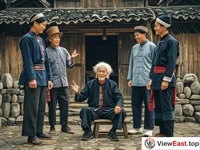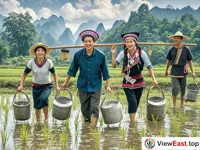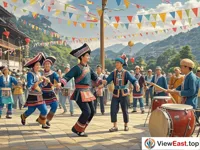







The Yao people are an important ethnic minority in the southwestern region of China, known for their unique social structure and rich family life. The social structure and family life of the Yao people not only reflect the profound cultural heritage of the Yao culture but also demonstrate the Yao people's emphasis on and maintenance of family ties. This article will introduce the social structure and family life of the Yao people from multiple dimensions, exploring the uniqueness and charm of their culture.
I. The Social Structure of the Yao People
The social structure of the Yao people centers on the family, with distinct clan characteristics:
Clan System: Yao society is based on clans as the fundamental unit, with strict hierarchies and responsibilities within the clans.
Elder System: Elders in Yao clans hold significant authority, responsible for handling clan affairs and resolving disputes.
Mutual Assistance and Cooperation: Yao society emphasizes mutual assistance and cooperation among clans to jointly face life's difficulties and challenges.
II. Family Life of the Yao People
The family life of the Yao people is rich and colorful, reflecting the wisdom of Yao people's lives and emotional bonds:
Family Ceremonies: There are abundant ceremonial activities in Yao families, such as weddings and funerals, which strengthen emotional ties among family members.
Family Education: Yao families place importance on the education of their children, passing down clan culture and values through oral history and skill transmission.
Festival Celebrations: Traditional Yao festivals, such as the Panwang Festival, are crucial moments for family reunions and cultural exchanges.
III. Cultural Heritage of the Yao People
Cultural heritage holds an important position in the family and clan context for the Yao people:
Oral Tradition: Much of Yao cultural traditions are preserved through intergenerational oral transmission within the family.
Garment Art: The exquisite craftsmanship of Yao attire is an essential part of Yao culture and a symbol of clan identity.
Music and Dance: Yao music and dance are indispensable elements in family and community activities, carrying rich cultural information.
IV. Modern Adaptation of the Yao People
In modern society, the Yao people face the integration and adaptation of tradition and modernity:
Cultural Preservation: With the acceleration of modernization, Yao culture faces challenges in protection and inheritance.
Economic Development: While developing the economy, Yao areas strive to maintain their unique social structure and family lifestyle.
Educational Reform: The education system in Yao areas gradually integrates modern educational concepts based on traditional education.
V. Conclusion
The social structure and family life of the Yao people are essential components of Yao culture, not only maintaining Yao family ties but also promoting the inheritance and development of Yao culture.